上篇總結了 Model-Free Predict 問題及方法,本文内容介紹 Model-Free Control 方法,即 "Optimise the value function of an unknown MDP"。
在這裡說明下,Model-Free Predict/Control 不僅适用于 Model-Free 的情況,其同樣适用于 MDP 已知的問題:
- MDP model is unknown, but experience can be sampled.
- MDP model is known, but is too big to use, except by samples.
在正式介紹 Model-Free Control 方法之前,我們先介紹下 On-policy Learning 及 Off-policy Learning。
On-policy Learning vs. Off-policy Learning
On-policy Learning:
- "Learn on the job"
- Learn about policy \(\pi\) from experience sampled from \(\pi\)(即采樣的政策與學習的政策一緻)
Off-policy Learning:
- "Look over someone's shoulder"
- Learn about policy \(\pi\) from experience sampled from \(\mu\)(即采樣的政策與學習的政策不一緻)
On-Policy Monte-Carlo Learning
Generalized Policy Iteration
具體的 Control 方法,在《動态規劃》一文中我們提到了 Model-based 下的廣義政策疊代 GPI 架構,那在 Model-Free 情況下是否同樣适用呢?
如下圖為 Model-based 下的廣義政策疊代 GPI 架構,主要分兩部分:政策評估及基于 Greedy 政策的政策提升。
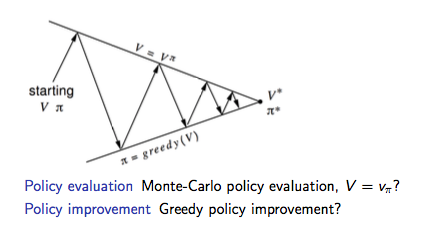
Model-Free 政策評估
在《Model-Free Predict》中我們分别介紹了兩種 Model-Free 的政策評估方法:MC 和 TD。我們先讨論使用 MC 情況下的 Model-Free 政策評估。
如上圖GPI架構所示:
- 基于 \(V(s)\) 的貪婪政策提升需要 MDP 已知:
\[\pi'(s) = \arg\max_{a\in A}\Bigl(R_{s}^{a}+P_{ss'}^{a}V(s')\Bigr)
\]
- 基于 \(Q(s, a)\) 的貪婪政策提升不需要 MDP 已知,即 Model-Free:
\[\pi'(s) = \arg\max_{a\in A}Q(s, a)
是以 Model-Free 下需要對 \(Q(s, a)\) 政策評估,整個GPI政策疊代也要基于 \(Q(s, a)\)。
Model-Free 政策提升
确定了政策評估的對象,那接下來要考慮的就是如何基于政策評估的結果 \(Q(s, a)\) 進行政策提升。
由于 Model-Free 的政策評估基于對經驗的 samples(即評估的 \(q(s, a)\) 存在 bias),是以我們在這裡不采用純粹的 greedy 政策,防止因為政策評估的偏差導緻整個政策疊代進入局部最優,而是采用具有 explore 功能的 \(\epsilon\)-greedy 算法:
\[\pi(a|s) =
\begin{cases}
&\frac{\epsilon}{m} + 1 - \epsilon, &\text{if } a^*=\arg\max_{a\in A}Q(s, a)\\
&\frac{\epsilon}{m}, &\text{otherwise}
\end{cases}
是以,我們确定了 Model-Free 下的 Monto-Carlo Control:
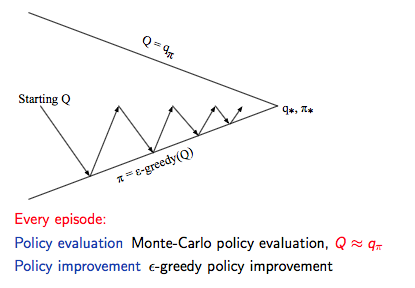
GLIE
先直接貼下David的課件,GLIE 介紹如下:

對于 \(\epsilon\)-greedy 算法而言,如果 \(\epsilon\) 随着疊代次數逐漸減為0,那麼 \(\epsilon\)-greedy 是 GLIE,即:
\[\epsilon_{k} = \frac{1}{k}
GLIE Monto-Carlo Control
GLIE Monto-Carlo Control:
- 對于 episode 中的每個狀态 \(S_{t}\) 和動作 \(A_t\):
\[N(S_t, A_t) ← N(S_t, A_t) + 1 \\
Q(S_t, A_t) ← Q(S_t, A_t) + \frac{1}{N(S_t, A_t)}(G_t - Q(S_t, A_t))
- 基于新的動作價值函數提升政策:
\[\epsilon ← \frac{1}{k}\\
\pi ← \epsilon\text{-greedy}(Q)
定理:GLIE Monto-Carlo Control 收斂到最優的動作價值函數,即:\(Q(s, a) → q_*(s, a)\)。
On-Policy Temporal-Difference Learning
Sarsa
我們之前總結過 TD 相對 MC 的優勢:
- 低方差
- Online
- 非完整序列
那麼一個很自然的想法就是在整個控制閉環中用 TD 代替 MC:
- 使用 TD 來計算 \(Q(S, A)\)
- 仍然使用 \(\epsilon\)-greedy 政策提升
- 每一個 step 進行更新
通過上述改變就使得 On-Policy 的蒙特卡洛方法變成了著名的 Sarsa。
- 更新動作價值函數

- Control
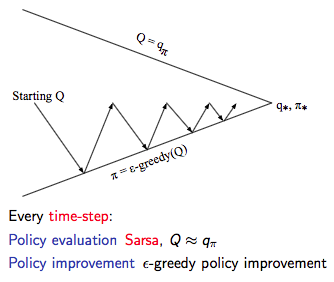
Sarsa算法的僞代碼如下:

Sarsa(λ)
n-step Sarsa returns 可以表示如下:
\(n=1\) 時:\(q_{t}^{(1)} = R_{t+1} + \gamma Q(S_{t+1})\)
\(n=2\) 時:\(q_{t}^{(2)} = R_{t+1} + \gamma R_{t+2} + \gamma^2 Q(S_{t+2})\)
...
\(n=\infty\) 時:\(q_{t}^{\infty} = R_{t+1} + \gamma R_{t+2} + ... + \gamma^{T-1} R_T\)
是以,n-step return \(q_{t}^{(n)} = R_{t+1} + \gamma R_{t+2} + ... + \gamma^{n}Q(S_{t+n})\)
n-step Sarsa 更新公式:
\[Q(S_t, A_t) ← Q(S_t, A_t) + \alpha (q_t^{(n)} - Q(S_t, A_t))
具體的 Sarsa(λ) 算法僞代碼如下:
其中 \(E(s, a)\) 為資格迹。
下圖為 Sarsa(λ) 用于 Gridworld 例子的示意圖:

Off-Policy Learning
Off-Policy Learning 的特點是評估目标政策 \(\pi(a|s)\) 來計算 \(v_{\pi}(s)\) 或者 \(q_{\pi}(s, a)\),但是跟随行為政策 \(\{S_1, A_1, R_2, ..., S_T\}\sim\mu(a|s)\)。
Off-Policy Learning 有什麼意義?
- Learn from observing humans or other agents
- Re-use experience generated from old policies \(\pi_1, \pi_2, ..., \pi_{t-1}\)
- Learn about optimal policy while following exploratory policy
- Learn about multiple policies while following one policy
重要性采樣
重要性采樣的目的是:Estimate the expectation of a different distribution。
\[\begin{align}
E_{X\sim P}[f(X)]
&= \sum P(X)f(X)\\
&= \sum Q(X)\frac{P(X)}{Q(X)}f(X)\\
&= E_{X\sim Q}[\frac{P(X)}{Q(X)}f(X)]
\end{align}
Off-Policy MC 重要性采樣
使用政策 \(\pi\) 産生的 return 來評估 \(\mu\):
\[G_t^{\pi/\mu} = \frac{\pi(A_t|S_t)}{\mu(A_t|S_t)} \frac{\pi(A_{t+1}|S_{t+1})}{\mu(A_{t+1}|S_{t+1})}...\frac{\pi(A_T|S_T)}{\mu(A_T|S_T)}G_t
朝着正确的 return 方向去更新價值:
\[V(S_t) ← V(S_t) + \alpha\Bigl(\color{Red}{G_t^{\pi/\mu}}-V(S_t)\Bigr)
需要注意兩點:
- Cannot use if \(\mu\) is zero when \(\pi\) is non-zero
- 重要性采樣會顯著性地提升方差
Off-Policy TD 重要性采樣
TD 是單步的,是以使用政策 \(\pi\) 産生的 TD targets 來評估 \(\mu\):
\[V(S_t) ← V(S_t) + \alpha\Bigl(\frac{\pi(A_t|S_t)}{\mu(A_t|S_t)}(R_{t+1}+\gamma V(S_{t+1}))-V(S_t)\Bigr)
- 方差比MC版本的重要性采樣低很多
Q-Learning
前面分别介紹了對價值函數 \(V(s)\) 進行 off-policy 學習,現在我們讨論如何對動作價值函數 \(Q(s, a)\) 進行 off-policy 學習:
- 不需要重要性采樣
- 使用行為政策選出下一步的動作:\(A_{t+1}\sim\mu(·|S_t)\)
- 但是仍需要考慮另一個後繼動作:\(A'\sim\pi(·|S_t)\)
- 朝着另一個後繼動作的價值更新 \(Q(S_t, A_t)\):
\[Q(S_t, A_t) ← Q(S_t, A_t) + \alpha\Bigl(R_{t+1}+\gamma Q(S_{t+1}, A')-Q(S_t, A_t)\Bigr)
讨論完對動作價值函數的學習,我們接着看如何通過 Q-Learning 進行 Control:
- 行為政策和目标政策均改進
- 目标政策 \(\pi\) 以greedy方式改進:
\[\pi(S_t) = \arg\max_{a'}Q(S_{t+1}, a')
- 行為政策 \(\mu\) 以 \(\epsilon\)-greedy 方式改進
- Q-Learning target:
&R_{t+1}+\gamma Q(S_{t+1}, A')\\
=&R_{t+1}+\gamma Q\Bigl(S_{t+1}, \arg\max_{a'}Q(S_{t+1}, a')\Bigr)\\
=&R_{t+1}+\max_{a'}\gamma Q(S_{t+1}, a')
Q-Learning 的 backup tree 如下所示:
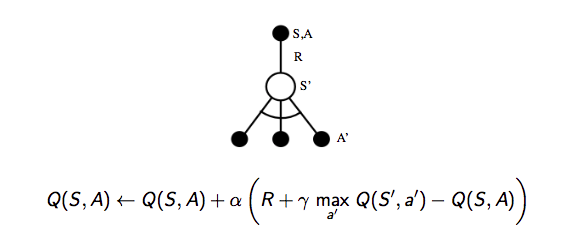
關于 Q-Learning 的結論:
Q-learning control converges to the optimal action-value function, \(Q(s, a)→q_*(s, a)\)
Q-Learning 算法具體的僞代碼如下:
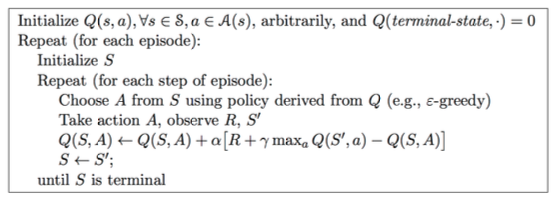
對比 Sarsa 與 Q-Learning 可以發現兩個最重要的差別:
- TD target 公式不同
- Q-Learning 中下一步的動作從行為政策中選出,而不是目标政策
DP vs. TD
兩者的差別見下表:
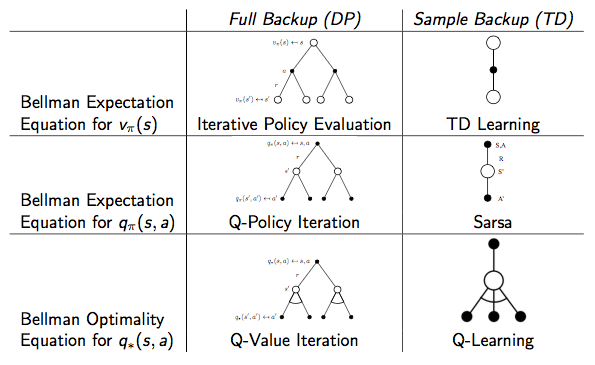
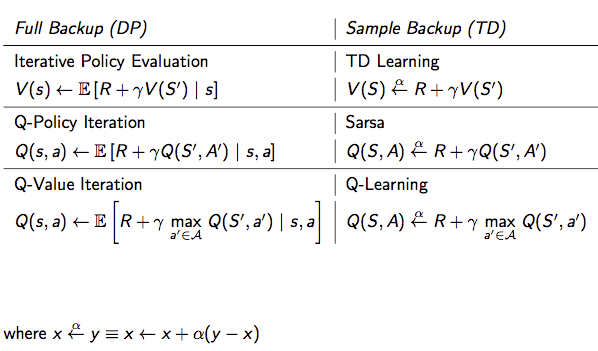
Reference
[1] Reinforcement Learning: An Introduction, Richard S. Sutton and Andrew G. Barto, 2018
[2] David Silver's Homepage
作者:Poll的筆記
部落格出處:http://www.cnblogs.com/maybe2030/
本文版權歸作者和部落格園所有,歡迎轉載,轉載請标明出處。
<如果你覺得本文還不錯,對你的學習帶來了些許幫助,請幫忙點選右下角的推薦>